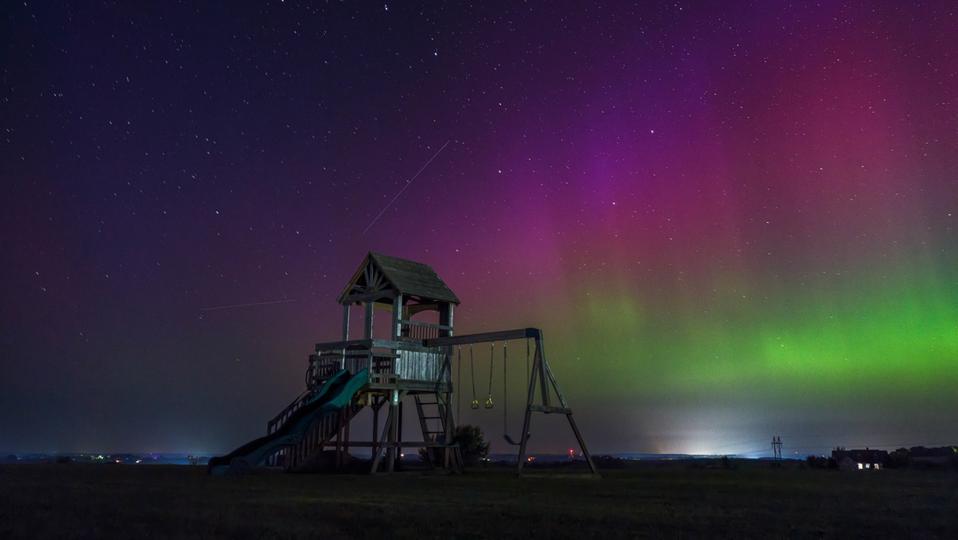


Sky-watchers across the northern U.S. could be treated to a fresh display of the Northern Lights over the next two nights as two coronal mass ejections from the sun approach Earth. The pair of solar storms are expected to arrive late Monday, Oct. 7, into Tuesday, Oct. 8, bringing an increased chance of geomagnetic activity and auroras at high and possibly mid-latitudes, according to NOAA’s Space Weather Prediction Center.
Although the bright Harvest Moon on Oct. 6 will wash out fainter auroras, any strong geomagnetic activity could still produce visible color and movement on the northern horizon — particularly from dark-sky locations in the northern tier of the U.S.
Solar activity remains at low to moderate levels, but Earth’s magnetic field is far from quiet. A persistent coronal hole — an opening in the Sun’s magnetic field — continues to stream fast solar wind toward Earth, while two slow-moving CMEs, launched on Friday, Oct. 3, are now en route.
According to Spaceweather.com, these CMEs are expected to arrive between late Oct. 7 and early Oct. 8, potentially combining their effects to trigger a G1-class geomagnetic storm. The precise timing is uncertain, as CME travel speed and direction can vary significantly, but when they arrive, they’ll likely reinforce the solar wind already buffeting Earth’s magnetic field.
Even weak solar storms can produce bright auroras when conditions are just right — and early October is one of those moments. Around the equinoxes in March and September, Earth’s magnetic field tilts into a more favorable orientation, allowing solar particles to interact more effectively with the magnetosphere.
This alignment, known as the Russell-McPherron effect, dramatically increases the likelihood of geomagnetic storms. When the Sun’s magnetic field turns southward, it links directly with Earth’s field, opening a pathway for energetic solar particles to enter the upper atmosphere. As those particles collide with oxygen and nitrogen atoms, they excite them into glowing — creating the green, purple, and red ribbons of light we recognize as the Northern Lights.
With the two CMEs expected to arrive during this favorable window, stronger auroral activity is possible across the northern hemisphere Monday night through Tuesday night.
NOAA’s current forecast calls for active geomagnetic conditions (Kp 4–5), with a chance of G1-class storming as the CMEs arrive. If activity reaches those levels, auroras could be visible low on the northern horizon across 12 U.S. states: Alaska, and northern parts of Washington, Idaho, Montana, Wyoming, North Dakota, South Dakota, Minnesota, Wisconsin, Michigan, New York, and Maine.
To maximize your chances, look north after dark, though with the moon so bright, driving into dark rural skies is likely not crucial. Check real-time aurora and solar wind data via NOAA’s 30-minute forecast or apps like My Aurora Forecast and Glendale Aurora.
The critical variable is the interplanetary magnetic field (Bz). If it turns southward, the door opens for auroral energy to flood into Earth’s atmosphere — often within minutes. Data on the Bz direction can be tracked on sites such as SpaceWeatherLive.com.
Moonlight may make faint aurora harder to see, but cameras will pick it up. A mirrorless or DSLR camera is ideal, but many newer smartphones can capture stunning aurora shots using Night Mode.
Even faint auroras can photograph beautifully, so don’t be discouraged if your eyes see only a pale glow.
The aurora is the visible expression of space weather — the interaction between the solar wind and Earth’s magnetic field. Most of the solar wind is deflected, but when CMEs or high-speed streams strike Earth’s magnetosphere, charged particles follow magnetic field lines toward the poles. Collisions with oxygen and nitrogen atoms in the upper atmosphere produce the characteristic colors: green from oxygen, and purple or red from nitrogen.
Wishing you clear skies and wide eyes.

